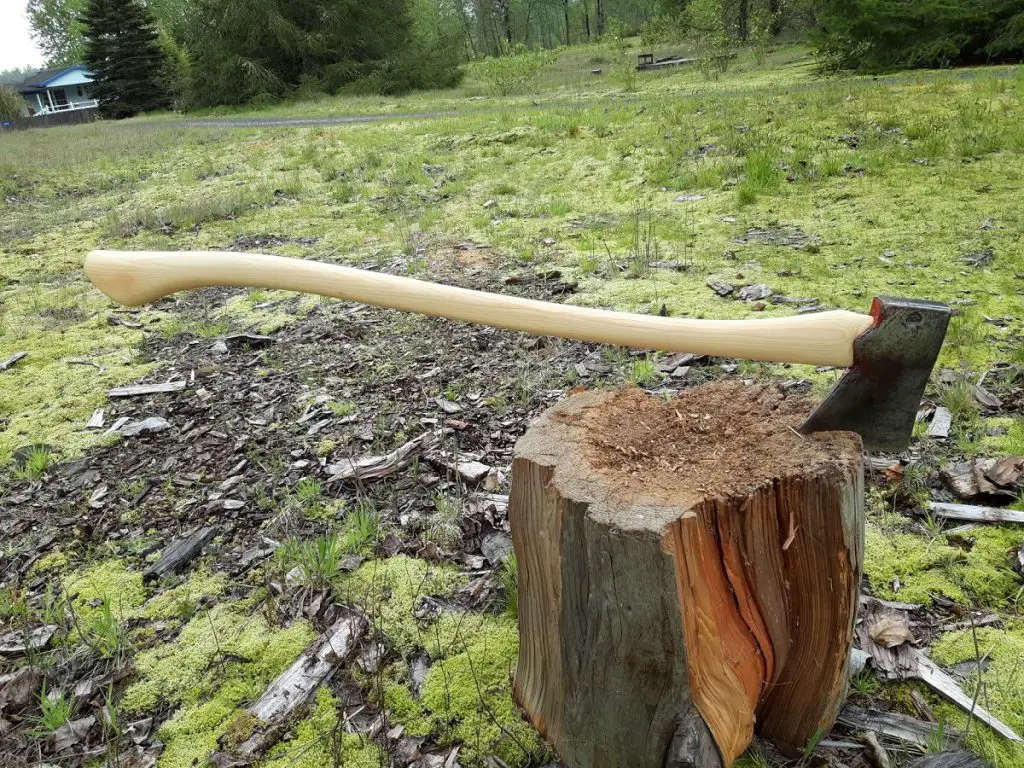Once you get into the world of axes, you learn that there are actually dozens of different axe and axe head types. Axes developed all over the world, and people made do with what they had and the unique needs of their location. The result is that axes from different states in the United States look different, let alone axes from different parts of the world.
The Jersey axe is one of the most popular axe types to this day. Sometimes called the Baltimore Jersey axe, this axe was originally from the American Middle Atlantic region but spread far and wide. Loggers and axe appreciators of all kinds like its lug extension and angular corners.
Here is everything you need to know about the Jersey axe.
Table of Contents
What Is a Jersey Axe?
A Jersey axe is a type of sturdy, versatile axe that originated in the United States. Its main characteristic is a lug where the axe head meets the handle, which gives the axe extra stability. The axe head is flat and broad, made out of sharp metal. It sits on a sturdy, mid-length handle made out of wood.
Jersey axes are very versatile. Most people historically used them for chopping wood, and that is what most people use them for today. They were also popular among firemen because they’re useful for chopping down debris and freeing a path through a collapsing building quickly.
On a far more casual note, Jersey axes are also popular among collectors. Axe aficionados love these sturdy axes that look like a page out of an Americana catalog. True obsessives try to get axes that have minor regional variations or come from popular brands.

Design Features of a Jersey Axe
If you’re a newcomer to the world of axes, it’s sometimes hard to tell different types of axes apart. Once you look closer, the Jersey axe has a few distinct features that set it apart from similar axes such as the Michigan axe.
The Blade
The Jersey axe’s blade is prototypical for what people would expect from an axe. The axe head has a single bit, meaning that it only has a blade on one side of the handle. The other side is smooth and rounded, hewing closely to the handle. The corners of the blade or axe-head are angular.
A Sturdy Handle
Jersey axes have sturdy handles that weigh anywhere from 2-8 pounds. The handles are usually made from American wood. The handle is slightly curved, divided into the belly and throat.
The Lug
The most distinctive part of the Jersey axe is the lug. The lug is the part of the axe cheek that extends downwards across the handle. On the Jersey axe, the lug is more prominent than the cheek on other types of axes, pointing downwards at an obtuse angle. This gives the axe more stability and precision because there is more surface area between the axe head and handle.
Bevels
Another distinct feature of the axe cheek on a Jersey axe is the bevel, or tapered line of the cheek. Bevels help reduce friction and make the axe more efficient and safer to use.
History of the Jersey Axe
It’s surprisingly difficult to get a definitive answer about the early history of the Jersey axe.
The United States was forged by its forests. In the early decades and centuries of our country, the timber industry was one of the most important parts of the economy. The industry developed by region, as many regions of what is now the United States were covered in lush forest. These forests varied region by region, meaning loggers in different regions adapted axes to meet their needs.
The Jersey axe originated in the Mid-Atlantic region, in New Jersey and around Baltimore in Maryland. This region had lush hardwood forests, meaning loggers needed a sturdier axe to cut down these tough trees.
We know that by the 19th century, manufacturers such as Douglas Axe were offering Jersey axes along with other types of axes. That means this was a well-established type of axe in the United States.
Today, the Jersey axe is still one of the most commonly made models, showing its versatility and timeless quality.
Modern Brands of Jersey Axe
Many manufacturers make the popular Jersey axe. Some of the most popular brands are:
- Council Tool
- Collins Commander
- Truper
Of these, Council Tool is definitely the most popular and one I would personally recommend.
Final Thoughts
You’ve probably seen Jersey axes with their single-blade axe heads, extra-long lug, and beveled cheeks while looking at axes. Now you know why they’re distinct from other types of axes, such as Michigan axes, and how they came to be.
